An Analysis of Sleeping Problems on University Students
VerifiedAdded on 2020/09/27
|19
|5306
|309
Report
AI Summary
This report critically analyzes the impacts of sleeping problems on university students, drawing on two peer-reviewed research papers: Satti et al. (2015) and Altun, Insaf et al. (2012). The report begins with an introduction highlighting the increasing prevalence of sleep disorders among university students and their consequences on academic performance, social life, and psychological well-being. It then presents the student's personal position, which is interpretivism, and a summary of the two research papers, focusing on their methodologies, findings, and geographical settings (Saudi Arabia and Turkey). The core of the report lies in its research critique, evaluating the literature review, research samples, and analytical processes of the selected papers. The analysis explores the reliability and validity of the research, assessing how the studies address research gaps and societal issues. The report concludes by summarizing the impacts of the research and reflecting on the review process. The student uses their own experiences and knowledge to analyze the research, offering a comprehensive understanding of the contributing factors to sleep problems among university students and their impacts.
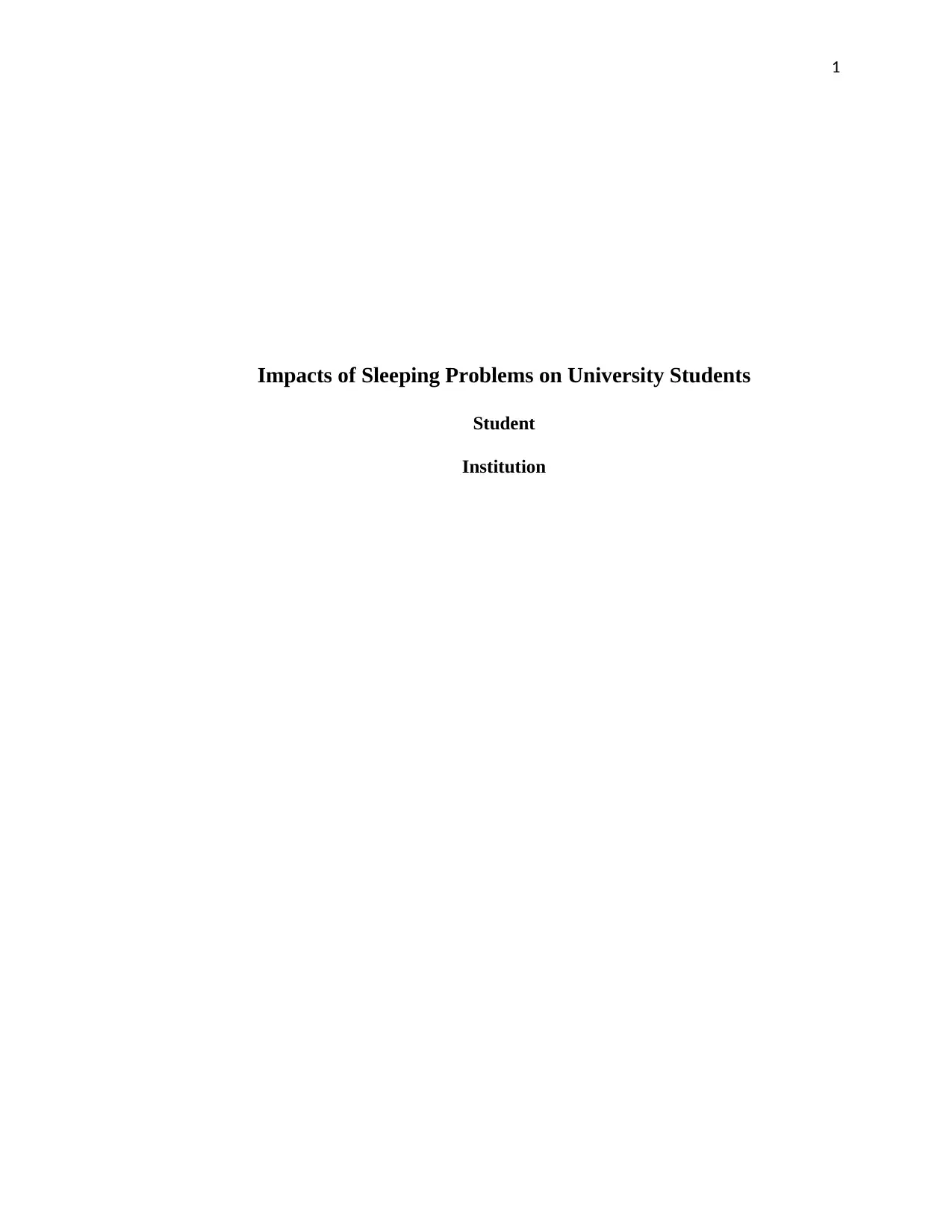
1
Impacts of Sleeping Problems on University Students
Student
Institution
Impacts of Sleeping Problems on University Students
Student
Institution
Paraphrase This Document
Need a fresh take? Get an instant paraphrase of this document with our AI Paraphraser

2
Table of Contents
1.0 Introduction................................................................................................................................3
2.0 My Personal Position.................................................................................................................4
3.0 Summary of the Papers..............................................................................................................5
4.0 Research Critiques.....................................................................................................................8
5.0 Impacts of this Research..........................................................................................................15
6.0 Conclusion...............................................................................................................................15
7.0 Reflection on Review Process.................................................................................................17
References......................................................................................................................................18
Table of Contents
1.0 Introduction................................................................................................................................3
2.0 My Personal Position.................................................................................................................4
3.0 Summary of the Papers..............................................................................................................5
4.0 Research Critiques.....................................................................................................................8
5.0 Impacts of this Research..........................................................................................................15
6.0 Conclusion...............................................................................................................................15
7.0 Reflection on Review Process.................................................................................................17
References......................................................................................................................................18
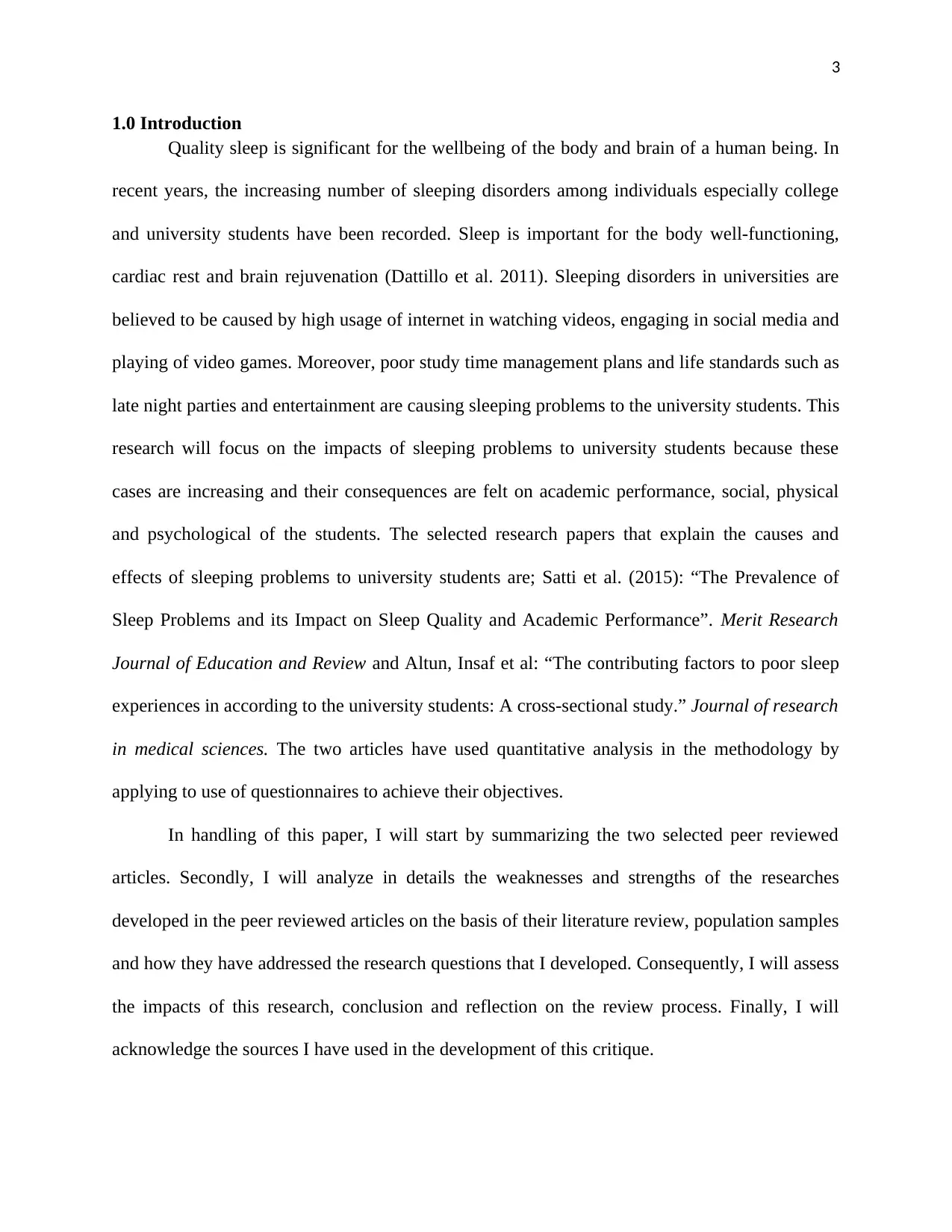
3
1.0 Introduction
Quality sleep is significant for the wellbeing of the body and brain of a human being. In
recent years, the increasing number of sleeping disorders among individuals especially college
and university students have been recorded. Sleep is important for the body well-functioning,
cardiac rest and brain rejuvenation (Dattillo et al. 2011). Sleeping disorders in universities are
believed to be caused by high usage of internet in watching videos, engaging in social media and
playing of video games. Moreover, poor study time management plans and life standards such as
late night parties and entertainment are causing sleeping problems to the university students. This
research will focus on the impacts of sleeping problems to university students because these
cases are increasing and their consequences are felt on academic performance, social, physical
and psychological of the students. The selected research papers that explain the causes and
effects of sleeping problems to university students are; Satti et al. (2015): “The Prevalence of
Sleep Problems and its Impact on Sleep Quality and Academic Performance”. Merit Research
Journal of Education and Review and Altun, Insaf et al: “The contributing factors to poor sleep
experiences in according to the university students: A cross-sectional study.” Journal of research
in medical sciences. The two articles have used quantitative analysis in the methodology by
applying to use of questionnaires to achieve their objectives.
In handling of this paper, I will start by summarizing the two selected peer reviewed
articles. Secondly, I will analyze in details the weaknesses and strengths of the researches
developed in the peer reviewed articles on the basis of their literature review, population samples
and how they have addressed the research questions that I developed. Consequently, I will assess
the impacts of this research, conclusion and reflection on the review process. Finally, I will
acknowledge the sources I have used in the development of this critique.
1.0 Introduction
Quality sleep is significant for the wellbeing of the body and brain of a human being. In
recent years, the increasing number of sleeping disorders among individuals especially college
and university students have been recorded. Sleep is important for the body well-functioning,
cardiac rest and brain rejuvenation (Dattillo et al. 2011). Sleeping disorders in universities are
believed to be caused by high usage of internet in watching videos, engaging in social media and
playing of video games. Moreover, poor study time management plans and life standards such as
late night parties and entertainment are causing sleeping problems to the university students. This
research will focus on the impacts of sleeping problems to university students because these
cases are increasing and their consequences are felt on academic performance, social, physical
and psychological of the students. The selected research papers that explain the causes and
effects of sleeping problems to university students are; Satti et al. (2015): “The Prevalence of
Sleep Problems and its Impact on Sleep Quality and Academic Performance”. Merit Research
Journal of Education and Review and Altun, Insaf et al: “The contributing factors to poor sleep
experiences in according to the university students: A cross-sectional study.” Journal of research
in medical sciences. The two articles have used quantitative analysis in the methodology by
applying to use of questionnaires to achieve their objectives.
In handling of this paper, I will start by summarizing the two selected peer reviewed
articles. Secondly, I will analyze in details the weaknesses and strengths of the researches
developed in the peer reviewed articles on the basis of their literature review, population samples
and how they have addressed the research questions that I developed. Consequently, I will assess
the impacts of this research, conclusion and reflection on the review process. Finally, I will
acknowledge the sources I have used in the development of this critique.
⊘ This is a preview!⊘
Do you want full access?
Subscribe today to unlock all pages.

Trusted by 1+ million students worldwide

4
2.0 My Personal Position
As stated in the previous section, both selected research papers analyze the effect of
sleeping problems on university students. Although the research papers differ in context, for
instance Satti et al (2015) focuses on female medical university students in Saudi Arabia while
Altun, Cinar and Dede (2012) focuses on random in-class survey in universities in Turkey, both
papers tries to answer the questions; what are contributing factors for poor sleeping patterns
among university students? And what are the effects of poor sleeping patterns to university
students?
The position that I will take is interpretivism. As a university student, I have in depth
experience of sleeping problems and therefore am in better position to explain and answer the
research questions. I will also use my position and knowledge acquired from other relevant
sources to integrate the research. The position provides a better position to understand this
research and to deliver a comprehensive report on the findings. Furthermore, in the university I
stay in the student hostels and I interact with students in classes, field, parties and in sleeping
places and through observation and relation, I have a good concept on the causes and effects of
poor sleeping patterns on the students.
From the selected research papers, my focus is to understand the contributing factors of
sleeping problems amid university students and the impacts of these problems on the students. In
order to evaluate whether the knowledge obtained from the peer reviewed articles can be used as
a baseline reference by larger population, I would consider if the researches are founded on
adequate literature review about the topics, if the population samples used by the researchers
have the capability of providing adequate, credible and reliable information on the subject under
research and also if the researches have provided an in depth understanding and assessment of
the research questions I have developed as a framework for this critique. Then, from my position,
2.0 My Personal Position
As stated in the previous section, both selected research papers analyze the effect of
sleeping problems on university students. Although the research papers differ in context, for
instance Satti et al (2015) focuses on female medical university students in Saudi Arabia while
Altun, Cinar and Dede (2012) focuses on random in-class survey in universities in Turkey, both
papers tries to answer the questions; what are contributing factors for poor sleeping patterns
among university students? And what are the effects of poor sleeping patterns to university
students?
The position that I will take is interpretivism. As a university student, I have in depth
experience of sleeping problems and therefore am in better position to explain and answer the
research questions. I will also use my position and knowledge acquired from other relevant
sources to integrate the research. The position provides a better position to understand this
research and to deliver a comprehensive report on the findings. Furthermore, in the university I
stay in the student hostels and I interact with students in classes, field, parties and in sleeping
places and through observation and relation, I have a good concept on the causes and effects of
poor sleeping patterns on the students.
From the selected research papers, my focus is to understand the contributing factors of
sleeping problems amid university students and the impacts of these problems on the students. In
order to evaluate whether the knowledge obtained from the peer reviewed articles can be used as
a baseline reference by larger population, I would consider if the researches are founded on
adequate literature review about the topics, if the population samples used by the researchers
have the capability of providing adequate, credible and reliable information on the subject under
research and also if the researches have provided an in depth understanding and assessment of
the research questions I have developed as a framework for this critique. Then, from my position,
Paraphrase This Document
Need a fresh take? Get an instant paraphrase of this document with our AI Paraphraser
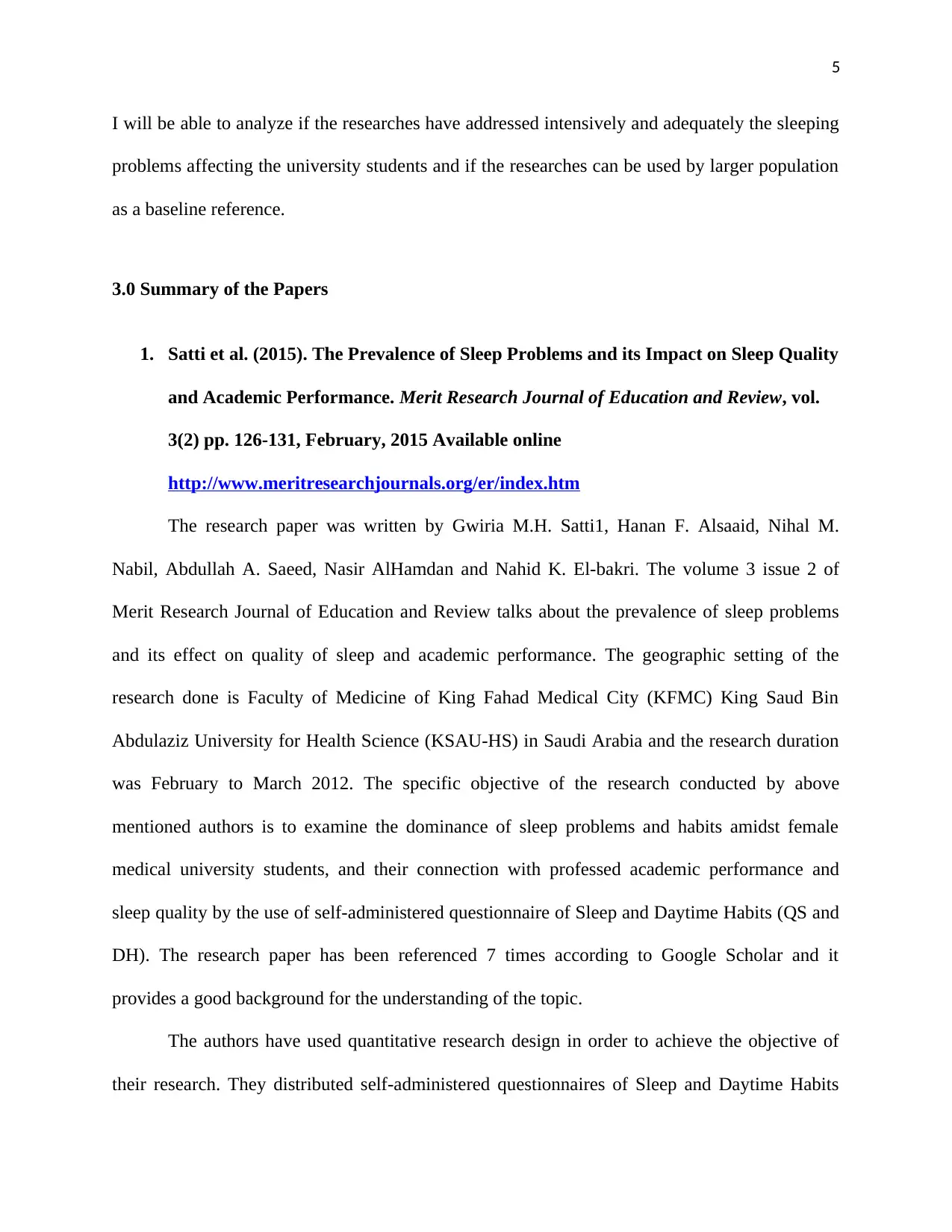
5
I will be able to analyze if the researches have addressed intensively and adequately the sleeping
problems affecting the university students and if the researches can be used by larger population
as a baseline reference.
3.0 Summary of the Papers
1. Satti et al. (2015). The Prevalence of Sleep Problems and its Impact on Sleep Quality
and Academic Performance. Merit Research Journal of Education and Review, vol.
3(2) pp. 126-131, February, 2015 Available online
http://www.meritresearchjournals.org/er/index.htm
The research paper was written by Gwiria M.H. Satti1, Hanan F. Alsaaid, Nihal M.
Nabil, Abdullah A. Saeed, Nasir AlHamdan and Nahid K. El-bakri. The volume 3 issue 2 of
Merit Research Journal of Education and Review talks about the prevalence of sleep problems
and its effect on quality of sleep and academic performance. The geographic setting of the
research done is Faculty of Medicine of King Fahad Medical City (KFMC) King Saud Bin
Abdulaziz University for Health Science (KSAU-HS) in Saudi Arabia and the research duration
was February to March 2012. The specific objective of the research conducted by above
mentioned authors is to examine the dominance of sleep problems and habits amidst female
medical university students, and their connection with professed academic performance and
sleep quality by the use of self-administered questionnaire of Sleep and Daytime Habits (QS and
DH). The research paper has been referenced 7 times according to Google Scholar and it
provides a good background for the understanding of the topic.
The authors have used quantitative research design in order to achieve the objective of
their research. They distributed self-administered questionnaires of Sleep and Daytime Habits
I will be able to analyze if the researches have addressed intensively and adequately the sleeping
problems affecting the university students and if the researches can be used by larger population
as a baseline reference.
3.0 Summary of the Papers
1. Satti et al. (2015). The Prevalence of Sleep Problems and its Impact on Sleep Quality
and Academic Performance. Merit Research Journal of Education and Review, vol.
3(2) pp. 126-131, February, 2015 Available online
http://www.meritresearchjournals.org/er/index.htm
The research paper was written by Gwiria M.H. Satti1, Hanan F. Alsaaid, Nihal M.
Nabil, Abdullah A. Saeed, Nasir AlHamdan and Nahid K. El-bakri. The volume 3 issue 2 of
Merit Research Journal of Education and Review talks about the prevalence of sleep problems
and its effect on quality of sleep and academic performance. The geographic setting of the
research done is Faculty of Medicine of King Fahad Medical City (KFMC) King Saud Bin
Abdulaziz University for Health Science (KSAU-HS) in Saudi Arabia and the research duration
was February to March 2012. The specific objective of the research conducted by above
mentioned authors is to examine the dominance of sleep problems and habits amidst female
medical university students, and their connection with professed academic performance and
sleep quality by the use of self-administered questionnaire of Sleep and Daytime Habits (QS and
DH). The research paper has been referenced 7 times according to Google Scholar and it
provides a good background for the understanding of the topic.
The authors have used quantitative research design in order to achieve the objective of
their research. They distributed self-administered questionnaires of Sleep and Daytime Habits
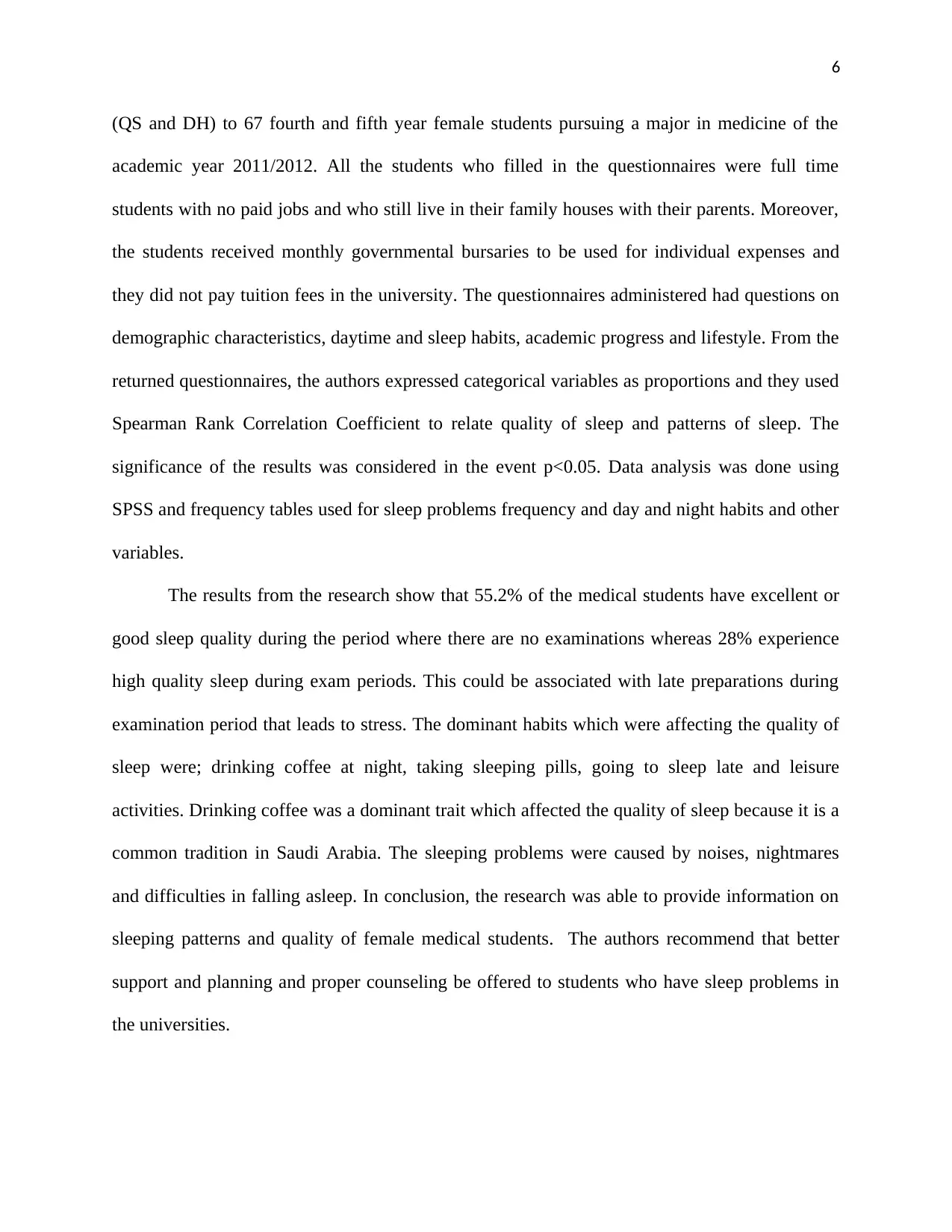
6
(QS and DH) to 67 fourth and fifth year female students pursuing a major in medicine of the
academic year 2011/2012. All the students who filled in the questionnaires were full time
students with no paid jobs and who still live in their family houses with their parents. Moreover,
the students received monthly governmental bursaries to be used for individual expenses and
they did not pay tuition fees in the university. The questionnaires administered had questions on
demographic characteristics, daytime and sleep habits, academic progress and lifestyle. From the
returned questionnaires, the authors expressed categorical variables as proportions and they used
Spearman Rank Correlation Coefficient to relate quality of sleep and patterns of sleep. The
significance of the results was considered in the event p<0.05. Data analysis was done using
SPSS and frequency tables used for sleep problems frequency and day and night habits and other
variables.
The results from the research show that 55.2% of the medical students have excellent or
good sleep quality during the period where there are no examinations whereas 28% experience
high quality sleep during exam periods. This could be associated with late preparations during
examination period that leads to stress. The dominant habits which were affecting the quality of
sleep were; drinking coffee at night, taking sleeping pills, going to sleep late and leisure
activities. Drinking coffee was a dominant trait which affected the quality of sleep because it is a
common tradition in Saudi Arabia. The sleeping problems were caused by noises, nightmares
and difficulties in falling asleep. In conclusion, the research was able to provide information on
sleeping patterns and quality of female medical students. The authors recommend that better
support and planning and proper counseling be offered to students who have sleep problems in
the universities.
(QS and DH) to 67 fourth and fifth year female students pursuing a major in medicine of the
academic year 2011/2012. All the students who filled in the questionnaires were full time
students with no paid jobs and who still live in their family houses with their parents. Moreover,
the students received monthly governmental bursaries to be used for individual expenses and
they did not pay tuition fees in the university. The questionnaires administered had questions on
demographic characteristics, daytime and sleep habits, academic progress and lifestyle. From the
returned questionnaires, the authors expressed categorical variables as proportions and they used
Spearman Rank Correlation Coefficient to relate quality of sleep and patterns of sleep. The
significance of the results was considered in the event p<0.05. Data analysis was done using
SPSS and frequency tables used for sleep problems frequency and day and night habits and other
variables.
The results from the research show that 55.2% of the medical students have excellent or
good sleep quality during the period where there are no examinations whereas 28% experience
high quality sleep during exam periods. This could be associated with late preparations during
examination period that leads to stress. The dominant habits which were affecting the quality of
sleep were; drinking coffee at night, taking sleeping pills, going to sleep late and leisure
activities. Drinking coffee was a dominant trait which affected the quality of sleep because it is a
common tradition in Saudi Arabia. The sleeping problems were caused by noises, nightmares
and difficulties in falling asleep. In conclusion, the research was able to provide information on
sleeping patterns and quality of female medical students. The authors recommend that better
support and planning and proper counseling be offered to students who have sleep problems in
the universities.
⊘ This is a preview!⊘
Do you want full access?
Subscribe today to unlock all pages.

Trusted by 1+ million students worldwide

7
2. Altun, Insaf et al. “The contributing factors to poor sleep experiences in according
to the university students: A cross-sectional study.” Journal of research in medical
sciences: the official journal of Isfahan University of Medical Sciences vol. 17, 6
(2012): 557-61.
The research paper was written by Insaf Altun, Nursan Cinar and Cemilr Dede. The
volume 17 issue 6 of Journal Research in Medical Sciences sheds light on the factors which
contribute to poor experience in sleep to university students. The geographical setting of this
research paper is Turkey and the duration of the research was April 19 to 27, 2011 with 256
participants who were university students of Kocaeli, Turkey. The main objective of the research
was to identify the factors which contributed to poor sleeping patterns among the university
students. The journal has been cited by 3 people and it provides a well-developed structure and
content of the topic.
The authors used quantitative approach in their design research by administering
subjective questionnaires to 256 Turkey university students of academic year 2011 to 2012. The
administered questionnaires had questions that captured intensive information on the topic. The
questions asked were on personal characteristics such as marital status, gender and age, factors
which determined the behavior of sleep and the effects of poor sleeping patterns and quality.
Both open-ended and closed-ended questionnaires formats were used to collect data on the
research. The data collected was analyzed by the use of statistical packet programmed
specifically SPSS version 16 statistical software and represented by percentages. From the 256
participants, 48% were male while 52% were female and the participants had age range of 17 to
24 years.
2. Altun, Insaf et al. “The contributing factors to poor sleep experiences in according
to the university students: A cross-sectional study.” Journal of research in medical
sciences: the official journal of Isfahan University of Medical Sciences vol. 17, 6
(2012): 557-61.
The research paper was written by Insaf Altun, Nursan Cinar and Cemilr Dede. The
volume 17 issue 6 of Journal Research in Medical Sciences sheds light on the factors which
contribute to poor experience in sleep to university students. The geographical setting of this
research paper is Turkey and the duration of the research was April 19 to 27, 2011 with 256
participants who were university students of Kocaeli, Turkey. The main objective of the research
was to identify the factors which contributed to poor sleeping patterns among the university
students. The journal has been cited by 3 people and it provides a well-developed structure and
content of the topic.
The authors used quantitative approach in their design research by administering
subjective questionnaires to 256 Turkey university students of academic year 2011 to 2012. The
administered questionnaires had questions that captured intensive information on the topic. The
questions asked were on personal characteristics such as marital status, gender and age, factors
which determined the behavior of sleep and the effects of poor sleeping patterns and quality.
Both open-ended and closed-ended questionnaires formats were used to collect data on the
research. The data collected was analyzed by the use of statistical packet programmed
specifically SPSS version 16 statistical software and represented by percentages. From the 256
participants, 48% were male while 52% were female and the participants had age range of 17 to
24 years.
Paraphrase This Document
Need a fresh take? Get an instant paraphrase of this document with our AI Paraphraser
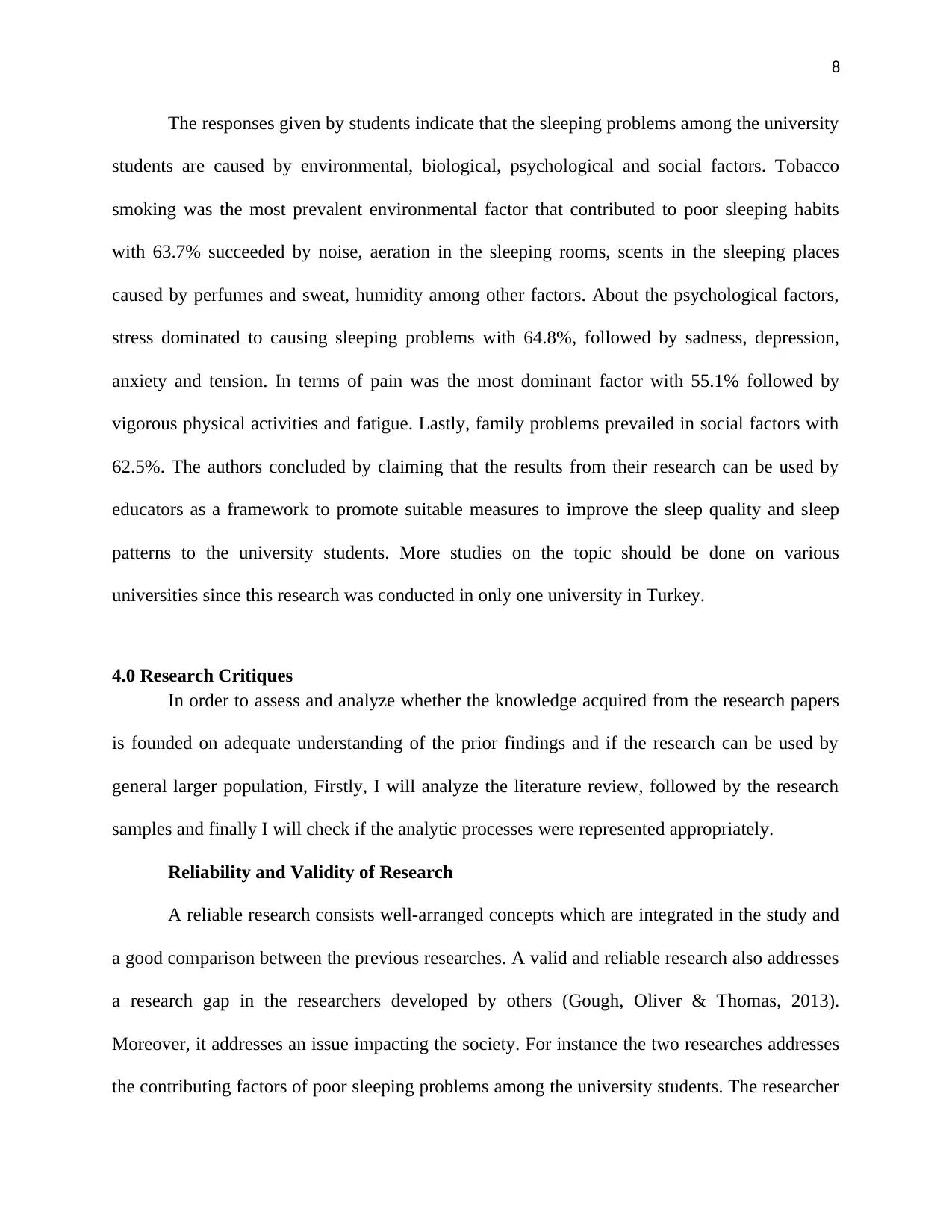
8
The responses given by students indicate that the sleeping problems among the university
students are caused by environmental, biological, psychological and social factors. Tobacco
smoking was the most prevalent environmental factor that contributed to poor sleeping habits
with 63.7% succeeded by noise, aeration in the sleeping rooms, scents in the sleeping places
caused by perfumes and sweat, humidity among other factors. About the psychological factors,
stress dominated to causing sleeping problems with 64.8%, followed by sadness, depression,
anxiety and tension. In terms of pain was the most dominant factor with 55.1% followed by
vigorous physical activities and fatigue. Lastly, family problems prevailed in social factors with
62.5%. The authors concluded by claiming that the results from their research can be used by
educators as a framework to promote suitable measures to improve the sleep quality and sleep
patterns to the university students. More studies on the topic should be done on various
universities since this research was conducted in only one university in Turkey.
4.0 Research Critiques
In order to assess and analyze whether the knowledge acquired from the research papers
is founded on adequate understanding of the prior findings and if the research can be used by
general larger population, Firstly, I will analyze the literature review, followed by the research
samples and finally I will check if the analytic processes were represented appropriately.
Reliability and Validity of Research
A reliable research consists well-arranged concepts which are integrated in the study and
a good comparison between the previous researches. A valid and reliable research also addresses
a research gap in the researchers developed by others (Gough, Oliver & Thomas, 2013).
Moreover, it addresses an issue impacting the society. For instance the two researches addresses
the contributing factors of poor sleeping problems among the university students. The researcher
The responses given by students indicate that the sleeping problems among the university
students are caused by environmental, biological, psychological and social factors. Tobacco
smoking was the most prevalent environmental factor that contributed to poor sleeping habits
with 63.7% succeeded by noise, aeration in the sleeping rooms, scents in the sleeping places
caused by perfumes and sweat, humidity among other factors. About the psychological factors,
stress dominated to causing sleeping problems with 64.8%, followed by sadness, depression,
anxiety and tension. In terms of pain was the most dominant factor with 55.1% followed by
vigorous physical activities and fatigue. Lastly, family problems prevailed in social factors with
62.5%. The authors concluded by claiming that the results from their research can be used by
educators as a framework to promote suitable measures to improve the sleep quality and sleep
patterns to the university students. More studies on the topic should be done on various
universities since this research was conducted in only one university in Turkey.
4.0 Research Critiques
In order to assess and analyze whether the knowledge acquired from the research papers
is founded on adequate understanding of the prior findings and if the research can be used by
general larger population, Firstly, I will analyze the literature review, followed by the research
samples and finally I will check if the analytic processes were represented appropriately.
Reliability and Validity of Research
A reliable research consists well-arranged concepts which are integrated in the study and
a good comparison between the previous researches. A valid and reliable research also addresses
a research gap in the researchers developed by others (Gough, Oliver & Thomas, 2013).
Moreover, it addresses an issue impacting the society. For instance the two researches addresses
the contributing factors of poor sleeping problems among the university students. The researcher

9
should develop an adequate background of the study by analyzing the research well and
reviewing the works done by other researchers.
Before embarking on their research, Gwiria, Hanan, Nihal, Abdullah, Nasir and Nahid
provided a background study by analyzing the previous findings of other researches and
elaborating on literature on the research topic. The authors start by stating the optimum duration
required for a normal human being to rest and factors which determine the sleeping patterns of
an individual. Moreover, they discuss on the importance of sleep and the prevalence of sleeping
problems which affect adults and adolescents. The authors elaborate that the sleep disturbance
problem is associated by factors like gender, age, physical exercises, lifestyle conditions and
workload (Satti et al, 2015: 126). The literature developed in this page forms the basis of the
research and it helps the reader to understand the purpose of research. The authors did not forget
to mention the effect of sleeping habits on the academic performance especially the medical
students who has a demanding academic schedule.
The authors acknowledge that the previous research done by Abdulghani et al., (2012)
was not adequate and there exist a research gap. This is a critical point in the literature review,
since the new research should address to fill the gap that was left by previous researchers on the
same topic. This makes the new research valid, relevant and reliable and it forms the basis and
the objective of research. The background information provided by the authors about the general
sleeping patterns and routine of students in Gulf Countries and Saudi Arabia and on the sleep
behavior during the examination periods is essential shows that the researchers understand the
geographical and behavioral characteristics of the sample population that will be used to provide
data for the research (Satti et al, 2015: 127). The researchers acknowledge other previous
researches on the topic in Saudi Arabia. They mention study done in King Saud University
should develop an adequate background of the study by analyzing the research well and
reviewing the works done by other researchers.
Before embarking on their research, Gwiria, Hanan, Nihal, Abdullah, Nasir and Nahid
provided a background study by analyzing the previous findings of other researches and
elaborating on literature on the research topic. The authors start by stating the optimum duration
required for a normal human being to rest and factors which determine the sleeping patterns of
an individual. Moreover, they discuss on the importance of sleep and the prevalence of sleeping
problems which affect adults and adolescents. The authors elaborate that the sleep disturbance
problem is associated by factors like gender, age, physical exercises, lifestyle conditions and
workload (Satti et al, 2015: 126). The literature developed in this page forms the basis of the
research and it helps the reader to understand the purpose of research. The authors did not forget
to mention the effect of sleeping habits on the academic performance especially the medical
students who has a demanding academic schedule.
The authors acknowledge that the previous research done by Abdulghani et al., (2012)
was not adequate and there exist a research gap. This is a critical point in the literature review,
since the new research should address to fill the gap that was left by previous researchers on the
same topic. This makes the new research valid, relevant and reliable and it forms the basis and
the objective of research. The background information provided by the authors about the general
sleeping patterns and routine of students in Gulf Countries and Saudi Arabia and on the sleep
behavior during the examination periods is essential shows that the researchers understand the
geographical and behavioral characteristics of the sample population that will be used to provide
data for the research (Satti et al, 2015: 127). The researchers acknowledge other previous
researches on the topic in Saudi Arabia. They mention study done in King Saud University
⊘ This is a preview!⊘
Do you want full access?
Subscribe today to unlock all pages.

Trusted by 1+ million students worldwide
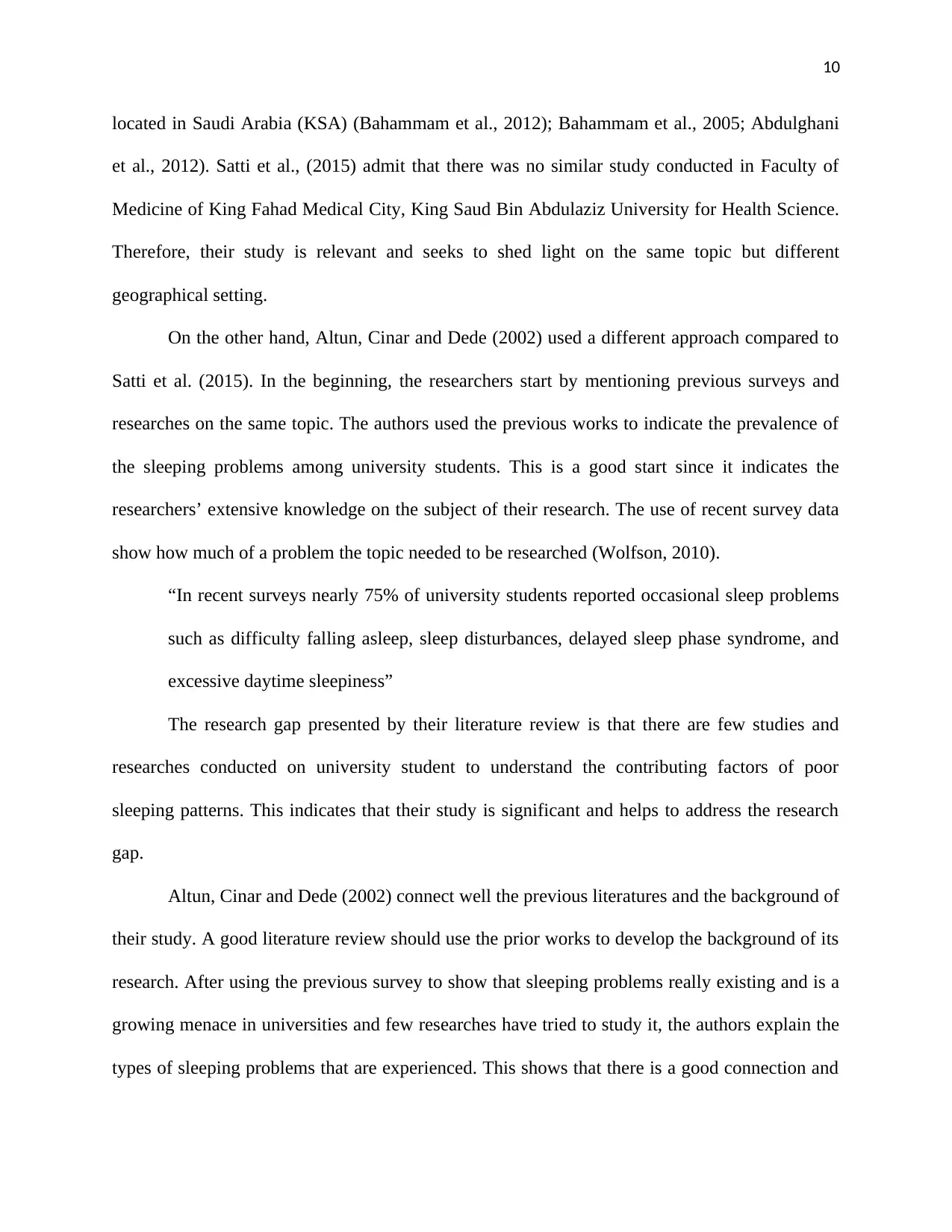
10
located in Saudi Arabia (KSA) (Bahammam et al., 2012); Bahammam et al., 2005; Abdulghani
et al., 2012). Satti et al., (2015) admit that there was no similar study conducted in Faculty of
Medicine of King Fahad Medical City, King Saud Bin Abdulaziz University for Health Science.
Therefore, their study is relevant and seeks to shed light on the same topic but different
geographical setting.
On the other hand, Altun, Cinar and Dede (2002) used a different approach compared to
Satti et al. (2015). In the beginning, the researchers start by mentioning previous surveys and
researches on the same topic. The authors used the previous works to indicate the prevalence of
the sleeping problems among university students. This is a good start since it indicates the
researchers’ extensive knowledge on the subject of their research. The use of recent survey data
show how much of a problem the topic needed to be researched (Wolfson, 2010).
“In recent surveys nearly 75% of university students reported occasional sleep problems
such as difficulty falling asleep, sleep disturbances, delayed sleep phase syndrome, and
excessive daytime sleepiness”
The research gap presented by their literature review is that there are few studies and
researches conducted on university student to understand the contributing factors of poor
sleeping patterns. This indicates that their study is significant and helps to address the research
gap.
Altun, Cinar and Dede (2002) connect well the previous literatures and the background of
their study. A good literature review should use the prior works to develop the background of its
research. After using the previous survey to show that sleeping problems really existing and is a
growing menace in universities and few researches have tried to study it, the authors explain the
types of sleeping problems that are experienced. This shows that there is a good connection and
located in Saudi Arabia (KSA) (Bahammam et al., 2012); Bahammam et al., 2005; Abdulghani
et al., 2012). Satti et al., (2015) admit that there was no similar study conducted in Faculty of
Medicine of King Fahad Medical City, King Saud Bin Abdulaziz University for Health Science.
Therefore, their study is relevant and seeks to shed light on the same topic but different
geographical setting.
On the other hand, Altun, Cinar and Dede (2002) used a different approach compared to
Satti et al. (2015). In the beginning, the researchers start by mentioning previous surveys and
researches on the same topic. The authors used the previous works to indicate the prevalence of
the sleeping problems among university students. This is a good start since it indicates the
researchers’ extensive knowledge on the subject of their research. The use of recent survey data
show how much of a problem the topic needed to be researched (Wolfson, 2010).
“In recent surveys nearly 75% of university students reported occasional sleep problems
such as difficulty falling asleep, sleep disturbances, delayed sleep phase syndrome, and
excessive daytime sleepiness”
The research gap presented by their literature review is that there are few studies and
researches conducted on university student to understand the contributing factors of poor
sleeping patterns. This indicates that their study is significant and helps to address the research
gap.
Altun, Cinar and Dede (2002) connect well the previous literatures and the background of
their study. A good literature review should use the prior works to develop the background of its
research. After using the previous survey to show that sleeping problems really existing and is a
growing menace in universities and few researches have tried to study it, the authors explain the
types of sleeping problems that are experienced. This shows that there is a good connection and
Paraphrase This Document
Need a fresh take? Get an instant paraphrase of this document with our AI Paraphraser
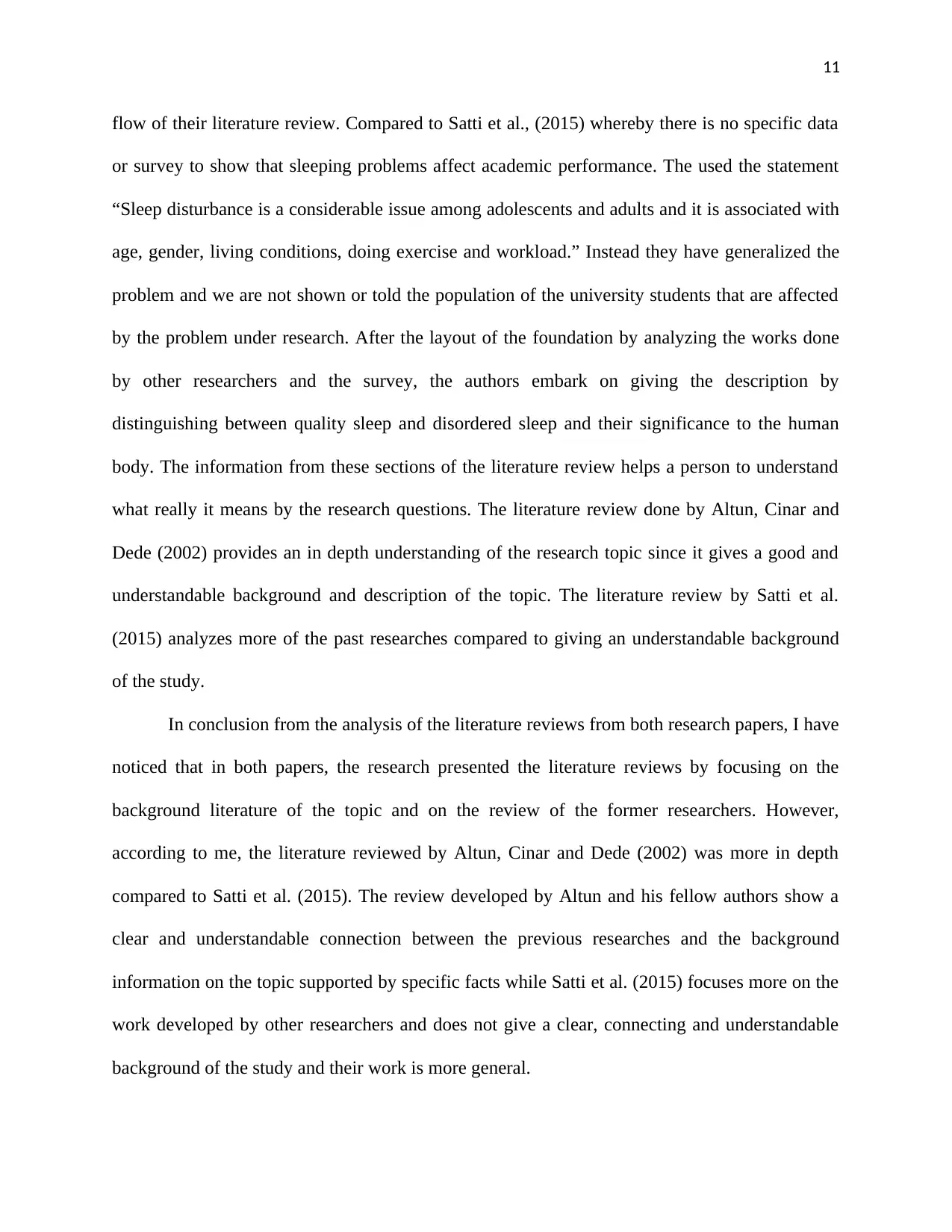
11
flow of their literature review. Compared to Satti et al., (2015) whereby there is no specific data
or survey to show that sleeping problems affect academic performance. The used the statement
“Sleep disturbance is a considerable issue among adolescents and adults and it is associated with
age, gender, living conditions, doing exercise and workload.” Instead they have generalized the
problem and we are not shown or told the population of the university students that are affected
by the problem under research. After the layout of the foundation by analyzing the works done
by other researchers and the survey, the authors embark on giving the description by
distinguishing between quality sleep and disordered sleep and their significance to the human
body. The information from these sections of the literature review helps a person to understand
what really it means by the research questions. The literature review done by Altun, Cinar and
Dede (2002) provides an in depth understanding of the research topic since it gives a good and
understandable background and description of the topic. The literature review by Satti et al.
(2015) analyzes more of the past researches compared to giving an understandable background
of the study.
In conclusion from the analysis of the literature reviews from both research papers, I have
noticed that in both papers, the research presented the literature reviews by focusing on the
background literature of the topic and on the review of the former researchers. However,
according to me, the literature reviewed by Altun, Cinar and Dede (2002) was more in depth
compared to Satti et al. (2015). The review developed by Altun and his fellow authors show a
clear and understandable connection between the previous researches and the background
information on the topic supported by specific facts while Satti et al. (2015) focuses more on the
work developed by other researchers and does not give a clear, connecting and understandable
background of the study and their work is more general.
flow of their literature review. Compared to Satti et al., (2015) whereby there is no specific data
or survey to show that sleeping problems affect academic performance. The used the statement
“Sleep disturbance is a considerable issue among adolescents and adults and it is associated with
age, gender, living conditions, doing exercise and workload.” Instead they have generalized the
problem and we are not shown or told the population of the university students that are affected
by the problem under research. After the layout of the foundation by analyzing the works done
by other researchers and the survey, the authors embark on giving the description by
distinguishing between quality sleep and disordered sleep and their significance to the human
body. The information from these sections of the literature review helps a person to understand
what really it means by the research questions. The literature review done by Altun, Cinar and
Dede (2002) provides an in depth understanding of the research topic since it gives a good and
understandable background and description of the topic. The literature review by Satti et al.
(2015) analyzes more of the past researches compared to giving an understandable background
of the study.
In conclusion from the analysis of the literature reviews from both research papers, I have
noticed that in both papers, the research presented the literature reviews by focusing on the
background literature of the topic and on the review of the former researchers. However,
according to me, the literature reviewed by Altun, Cinar and Dede (2002) was more in depth
compared to Satti et al. (2015). The review developed by Altun and his fellow authors show a
clear and understandable connection between the previous researches and the background
information on the topic supported by specific facts while Satti et al. (2015) focuses more on the
work developed by other researchers and does not give a clear, connecting and understandable
background of the study and their work is more general.
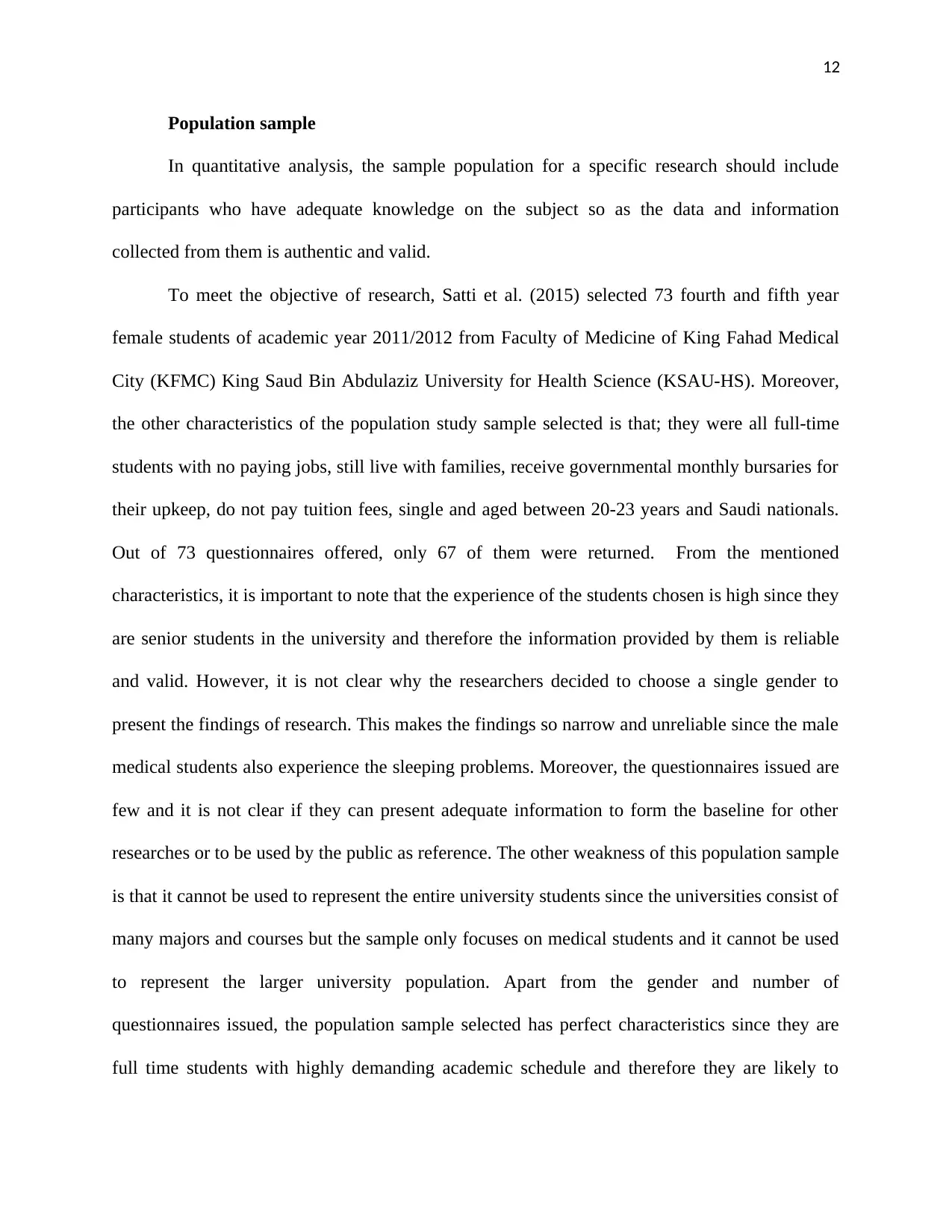
12
Population sample
In quantitative analysis, the sample population for a specific research should include
participants who have adequate knowledge on the subject so as the data and information
collected from them is authentic and valid.
To meet the objective of research, Satti et al. (2015) selected 73 fourth and fifth year
female students of academic year 2011/2012 from Faculty of Medicine of King Fahad Medical
City (KFMC) King Saud Bin Abdulaziz University for Health Science (KSAU-HS). Moreover,
the other characteristics of the population study sample selected is that; they were all full-time
students with no paying jobs, still live with families, receive governmental monthly bursaries for
their upkeep, do not pay tuition fees, single and aged between 20-23 years and Saudi nationals.
Out of 73 questionnaires offered, only 67 of them were returned. From the mentioned
characteristics, it is important to note that the experience of the students chosen is high since they
are senior students in the university and therefore the information provided by them is reliable
and valid. However, it is not clear why the researchers decided to choose a single gender to
present the findings of research. This makes the findings so narrow and unreliable since the male
medical students also experience the sleeping problems. Moreover, the questionnaires issued are
few and it is not clear if they can present adequate information to form the baseline for other
researches or to be used by the public as reference. The other weakness of this population sample
is that it cannot be used to represent the entire university students since the universities consist of
many majors and courses but the sample only focuses on medical students and it cannot be used
to represent the larger university population. Apart from the gender and number of
questionnaires issued, the population sample selected has perfect characteristics since they are
full time students with highly demanding academic schedule and therefore they are likely to
Population sample
In quantitative analysis, the sample population for a specific research should include
participants who have adequate knowledge on the subject so as the data and information
collected from them is authentic and valid.
To meet the objective of research, Satti et al. (2015) selected 73 fourth and fifth year
female students of academic year 2011/2012 from Faculty of Medicine of King Fahad Medical
City (KFMC) King Saud Bin Abdulaziz University for Health Science (KSAU-HS). Moreover,
the other characteristics of the population study sample selected is that; they were all full-time
students with no paying jobs, still live with families, receive governmental monthly bursaries for
their upkeep, do not pay tuition fees, single and aged between 20-23 years and Saudi nationals.
Out of 73 questionnaires offered, only 67 of them were returned. From the mentioned
characteristics, it is important to note that the experience of the students chosen is high since they
are senior students in the university and therefore the information provided by them is reliable
and valid. However, it is not clear why the researchers decided to choose a single gender to
present the findings of research. This makes the findings so narrow and unreliable since the male
medical students also experience the sleeping problems. Moreover, the questionnaires issued are
few and it is not clear if they can present adequate information to form the baseline for other
researches or to be used by the public as reference. The other weakness of this population sample
is that it cannot be used to represent the entire university students since the universities consist of
many majors and courses but the sample only focuses on medical students and it cannot be used
to represent the larger university population. Apart from the gender and number of
questionnaires issued, the population sample selected has perfect characteristics since they are
full time students with highly demanding academic schedule and therefore they are likely to
⊘ This is a preview!⊘
Do you want full access?
Subscribe today to unlock all pages.

Trusted by 1+ million students worldwide
1 out of 19
Related Documents
Your All-in-One AI-Powered Toolkit for Academic Success.
+13062052269
info@desklib.com
Available 24*7 on WhatsApp / Email
![[object Object]](/_next/static/media/star-bottom.7253800d.svg)
Unlock your academic potential
Copyright © 2020–2025 A2Z Services. All Rights Reserved. Developed and managed by ZUCOL.





